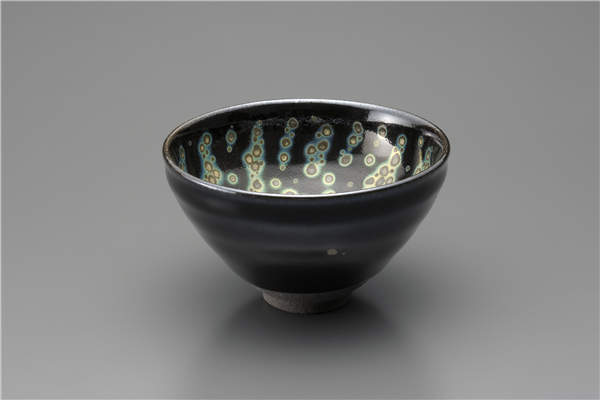
Jian zhan tea bowls were ideal for appreciating the light frothy foam. The bowls had deep blacks and reds with flecks of gold-the perfect contrast to the white and green of the tea, making the tea seem even more pure.
Another method used was oil-spot glazing, one of the most difficult glazing techniques. It required precision in the application, the firing conditions and the cooling process.
Oil spots occur when there is an excess of iron oxide, which is allowed to cool slowly and form radiant spots on the surface.
In the 13th century, jian zhan ware was introduced to Japan by its Buddhist monks returning from their studies in China.
Japan's Ashikaga shoguns (1336-1573), both warriors and avid tea practitioners, promoted the use of the Chinese-made tea bowls in chado, or the Japanese tea ceremony. Since then, yohen tenmoku tea bowls have held a revered position in the history and development of chado.
The Song Dynasty came to an abrupt end in the wake of the Mongol nomads, and with it, powdered tea gave way to tea leaves. The secrets of jian zhan glazing and firing techniques were lost.
In contrast, Japan continued the tradition of the Song Dynasty. With their source of yohen tenmoku bowls cut off, they created replicas.
China has excavated many fragments of jian zhan ware but not a single complete piece. The only four remaining complete examples of the chinaware fired in the Song Dynasty exist in Japan.
Three of them are designated as National Treasures of Japan, kept in the Seikado Bunko Art Museum in Tokyo, the Fujita Art Museum in Osaka and the Ryuukouin Subtemple of the Daitokuji Temple in Kyoto. The fourth is in the Miho Museum outside of Kyoto, and the piece's existence was not widely known until fairly recently.
Up to the 1990s, it was widely believed that the techniques and quality of the Song Dynasty could not be replicated.
To learn more about the tradition and techniques of Song ceramic artisans, Hayashi traveled to Fujian to look for relics of yohen tenmoku before their glaze was changed by kiln firing.
He was lucky to find one that was exactly what he wanted.
"It was helpful in my study on replicating the yohen tenmoku ceramics," says Hayashi.


















































